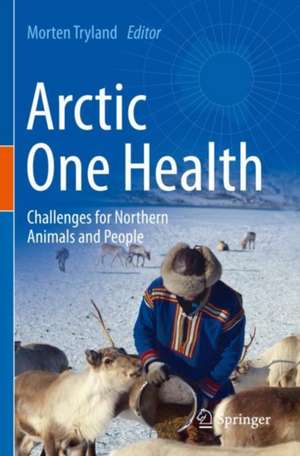Arctic One Health: Challenges for Northern Animals and People
Editat de Morten Trylanden Limba Engleză Paperback – 24 apr 2023
"Arctic One Health" is authored by experts based in arctic regions spanning from North America over Europe to Asia to cover a broad range of topics and perspectives. The book addresses researchers in Veterinary Medicine, Ecology, Microbiology and Anthropology. The book contributes towards achieving the UN Sustainable Developmental Goals, in particular SDG 15, Life on Land.
| Toate formatele și edițiile | Preț | Express |
|---|---|---|
| Paperback (1) | 1425.97 lei 6-8 săpt. | |
| Springer International Publishing – 24 apr 2023 | 1425.97 lei 6-8 săpt. | |
| Hardback (1) | 1433.46 lei 6-8 săpt. | |
| Springer International Publishing – 24 apr 2022 | 1433.46 lei 6-8 săpt. |
Preț: 1425.97 lei
Preț vechi: 1501.03 lei
-5% Nou
Puncte Express: 2139
Preț estimativ în valută:
272.85€ • 284.91$ • 225.32£
272.85€ • 284.91$ • 225.32£
Carte tipărită la comandă
Livrare economică 15-29 aprilie
Preluare comenzi: 021 569.72.76
Specificații
ISBN-13: 9783030878559
ISBN-10: 3030878554
Pagini: 573
Ilustrații: XIX, 573 p. 102 illus., 94 illus. in color.
Dimensiuni: 155 x 235 mm
Greutate: 0.82 kg
Ediția:1st ed. 2022
Editura: Springer International Publishing
Colecția Springer
Locul publicării:Cham, Switzerland
ISBN-10: 3030878554
Pagini: 573
Ilustrații: XIX, 573 p. 102 illus., 94 illus. in color.
Dimensiuni: 155 x 235 mm
Greutate: 0.82 kg
Ediția:1st ed. 2022
Editura: Springer International Publishing
Colecția Springer
Locul publicării:Cham, Switzerland
Cuprins
Part 1: Introduction.- The Arctic Region And Its Inhabitants.- A Holistic Approach To One Health In The Arctic.- Seasonal Animal Migrations And The Arctic.- Part 2: Major Health Threats To Arctic Animals And People.- Climate Change In Northern Regions.- Loss Of Untouched Land.- Arctic Ecosystems, Wildlife And Man - Threats From Persistent Organic Pollutants And Mercury.- Oil Spills In The Arctic.- Nuclear Radiation.- Part 3: Arctic Zoonoses - Diseases Transmitted From Animals To Man.- Rabies In The Arctic.- Brucellosis In The Arctic And Northern Regions.- Anthrax In The North.- Cystic And Alveolar Echinococcosis.- Toxoplasmosis In Northern Regions.- Trichinella Spp. In The North.- Cryptosporidiosis And Giardiosis In The Arctic: Increasing Threats In A Warmer World?.- Erysipelas In The Arctic And Northern Regions.- Tularemia In The Arctic.- Orthohantavirus In The Arctic - Presence And Future.- Zoonotic Marine Helminths: Anisakid Nematodes And Diphyllobothriid Cestodes.- Parapoxvirus Infections In Norhtern Species And Populations.- Part 4: Harvesting The Arctic - Potential Health Threats For Arctic People.- Hunting With Lead Ammunition - A One Health Perspective.- Traditional Conservation Methods And Food Habits In The Arctic.- Part 5: Working With Arctic Communities.- Wildlife Health Surveillance In The Arctic.- Dogs And People - Providing Veterinary Services To Remote Arctic Communities.- Semi-Domesticated Reindeer, Health And Animal Welfare.
Notă biografică
Dr. Morten Tryland is a professor in veterinary medicine – infection biology. After a period of clinical veterinary practice, he transitioned to research in virology and wildlife diseases. He has worked for 30 years in northern and arctic regions with infectious diseases, zoonoses, wildlife reservoirs and disease transmission in populations. He has been a member of the Norwegian Scientific Committee for Food Safety (Panel on Biological Hazards) and the European Food Safety Authority (EFSA; Panel on Biological Hazards), and he is currently the Norwegian editor of the scientific journal Acta Veterinaria Scandinavica. Although Dr. Tryland has been involved in several research projects in South-East African countries, he has spent most of his research career investigating infectious diseases and zoonoses in arctic wildlife and semi-domesticated reindeer. He has led or participated in projects addressing how infectious agents impact humans and wildlife in the vulnerable northern ecosystems in Alaska, Canada, Iceland and Fennoscandia, including the Svalbard Archipelago. He has spent a sabbatical period at the University of Fairbanks, Alaska, USA, and at East Iceland Nature Research Centre, Egilsstadir, Iceland. Dr. Tryland recently started in a new position, as a professor in One Health at Inland Norway University of Life Sciences, Koppang, Norway.
Textul de pe ultima copertă
This multidisciplinary book discusses the manifold challenges arctic marine and terrestrial wildlife, ecosystems and people face these times. Major health threats caused by the consequences of climate change, environmental pollution and increasing tourism in northern regions around the globe are explored. The most common infectious diseases in wild and domesticated arctic animals are reviewed and the impact they could have on circumpolar ecosystems as well as on the lives of arctic people are profoundly discussed. Moreover, the book reviews arctic hunting, herding and food conservation strategies and introduces veterinary medicine in remote indigenous communities.
"Arctic One Health" is authored by experts based in arctic regions spanning from North America over Europe to Asia to cover a broad range of topics and perspectives. The book addresses researchers in Veterinary Medicine, Ecology, Microbiology and Anthropology. The book contributes towards achieving the UN Sustainable Developmental Goals, in particular SDG 15, Life on Land.
Caracteristici
Discusses the most prevalent infectious diseases in arctic wildlife Examines the impact of arctic wildlife health on the ecosystem and arctic peoples Highlights food production and conservation strategies in arctic regions
